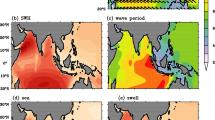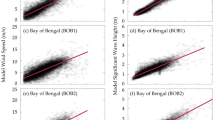Abstract
Studies related to the combined effect of different atmospheric oscillations on the ocean surface waves are limited. The present study focuses on the change in wave climatology due to the combined effect of Boreal Summer Intra-Seasonal Oscillation (BSISO) and El Niño Southern Oscillation (ENSO) using 40 years of reanalysis data on the Asian Summer Monsoon Region (ASMR). Composite analysis of surface wind, significant wave height, wind-sea, swell and mean wave period are analysed corresponding to different ENSO–BSISO phase combinations. The study showed noteworthy differences in wave parameters when ENSO–BSISO phases are analysed together. In El Niño–BSISO combined phase, enhancement of north-easterly wind causes the advancement in the reversal of wind direction (north-easterly to monsoon enhanced south-westerly) and disrupted propagation of positive wind and wave anomalies. Conversely, during La Niña–BSISO co-occurrence, south-westerlies are enhanced and as a result, the negative north-easterly anomalies are disrupted. In all the ENSO–BSISO combined phases, maximum wave height variability occurs at the South China Sea owing to the combined action of the north Indian Ocean (NIO) and Western North Pacific (WNP) surface wind forcing. High fluctuations in Tm over the NIO and WNP are observed during different ENSO–BSISO phase combinations. The phase relationship of Hs with Tm and the significant height of wind-sea (Hsw) and swell (Hss) are assessed to understand the propagation of swells. Due to the effect of multiple atmospheric perturbations, significant changes in Hs occur over the coastal regions of the NIO.









Similar content being viewed by others
References
Aboobacker VM, Rashmi R, Vethamony P, Menon HB (2011) On the dominance of pre-existing swells over wind seas along the west coast of India. Cont Shelf Res 31:1701–1712. https://doi.org/10.1016/j.csr.2011.07.010
Aboobacker VM, Shanas PR, Al-Ansari EMAS et al (2020) The maxima in northerly wind speeds and wave heights over the Arabian Sea, the Arabian/Persian Gulf and the Red Sea derived from 40 years of ERA5 data. Clim Dyn. https://doi.org/10.1007/s00382-020-05518-6
Amrutha MM, Sanil Kumar V (2017) Characteristics of high monsoon wind-waves observed at multiple stations in the eastern Arabian Sea. Ocean Sci Discuss. https://doi.org/10.5194/os-2017-84
Amrutha MM, Sanil Kumar V, Sharma S et al (2015) Characteristics of shallow water waves off the central west coast of India before, during and after the onset of the Indian summer monsoon. Ocean Eng 107:259–270. https://doi.org/10.1016/j.oceaneng.2015.07.061
Amrutha MM, Kumar VS, George J (2017) Observations of long-period waves in the nearshore waters of central west coast of India during the fall inter-monsoon period. Ocean Eng 131:244–262. https://doi.org/10.1016/j.oceaneng.2017.01.014
Amrutha MM, Sanil Kumar V, Bhaskaran H, Naseef TM (2019) Consistency of wave power at a location in the coastal waters of central eastern Arabian Sea. Ocean Dyn 69:543–560. https://doi.org/10.1007/s10236-019-01267-1
Anoop TR, Kumar VS, Shanas PR, Johnson G (2015) Surface wave climatology and its variability in the north Indian Ocean based on ERA-interim reanalysis. J Atmos Ocean Technol 32:1372–1385. https://doi.org/10.1175/JTECH-D-14-00212.1
Chen X, Li C, Li X (2020) Influences of ENSO on boreal summer intraseasonal oscillation over the western Pacific in decaying summer. Clim Dyn 54:3461–3473. https://doi.org/10.1007/s00382-020-05183-9
Chu PC, Qi Y, Chen Y et al (2004) South China Sea wind-wave characteristics. Part 1: validation of wavematch-III using TOPEX/Poseidon data. J Atmos Ocean Technol 21(11):1718–1733. https://doi.org/10.1175/JTECH1661.1
Duchon CE (1979) Lanczos filtering in one and two dimensions. J Appl Meteorol 18(8):1016–1022. https://doi.org/10.1175/1520-0450(1979)018<1016:LFIOAT>2.0.CO;2
Findlater J (1969) A major low-level air current near the Indian Ocean during the northern summer. Quart J Royal Meteorologic Soc 95(404):362–380. https://doi.org/10.1002/qj.49709540409
Glejin J, Kumar VS, Nair TMB (2013) Monsoon and cyclone induced wave climate over the near shore waters off Puduchery, south western Bay of Bengal. Ocean Eng 72:277–286. https://doi.org/10.1016/j.oceaneng.2013.07.013
Godoi VA, de Andrade FM, Bryan KR, Gorman RM (2019) Regional-scale ocean wave variability associated with El Niño–Southern Oscillation–Madden–Julian Oscillation combined activity. 39,483– 494. Int J Climatol. https://doi.org/10.1002/joc.5823
Godoi VA, de Andrade FM, Durrant TH, Torres Júnior AR (2020) What happens to the ocean surface gravity waves when ENSO and MJO phases combine during the extended boreal. winter? Clim Dyn 54:1407–1424. https://doi.org/10.1007/s00382-019-05065-9
Grimm AM, Ambrizzi T (2009) Teleconnections into South America from the tropics and extratropics on interannual and intraseasonal timescales. In: Vimeux F, Sylvestre F, Khodri M. (eds) Past climate variability in South America and surrounding regions. Developments in Paleoenvironmental Research, vol 14. Springer, Dordrecht. https://doi.org/10.1007/978-90-481-2672-9_7
Han S, Fan Y, Dong Y et al (2017) A study on the relationships between the wave height and the El Niño in the north area of the South China Sea. Acta Oceanol Sin 36:44–50. https://doi.org/10.1007/s13131-017-1059-2
Hersbach H, Bell B, Berrisford P et al (2020) The ERA5 global reanalysis. Q J R Meteorol Soc. 146:1999–2049. https://doi.org/10.1002/qj.3803
Hsu P, LeeJ,Ha K, Tsou C (2017) Influences of Boreal Summer Intraseasonal Oscillation on Heat Waves in Monsoon Asia. J Clim 30(18):7191–7211. https://doi.org/10.1175/JCLI-D-16-0505.1
Jiang H, Chen G (2013) A global view on the swell and wind sea climate by the Jason-1 mission: a revisit. J Atmos Ocean Technol 30(8):1833–1841. https://doi.org/10.1175/JTECH-D-12-00180.1
Jiang X, Li T, Wang B (2004) Structures and mechanisms of the northward propagating boreal summer intraseasonal oscillation. J Clim 17(5):1022–1039. https://doi.org/10.1175/1520-0442(2004)017<1022:SAMOTN>2.0.CO;2
Kikuchi K, Wang B, Kajikawa Y (2012) Bimodal representation of the tropical intraseasonal oscillation. Clim Dyn 38:1989–2000. https://doi.org/10.1007/s00382-011-1159-1
Klein SA, Soden BJ, Lau NC (1999) Remote sea surface temperature variations during ENSO: evidence for a tropical atmospheric bridge. J Clim. 12(4):917–932. https://doi.org/10.1175/1520-0442(1999)012<0917:RSSTVD>2.0.CO;2
Krishnamurti TN, Subrahmanyam D (1982) The 30–50 day mode at 850 mb during MONEX. J Atmos Sci 39(9):2088–2095. https://doi.org/10.1175/1520-0469(1982)039<2088:TDMAMD>2.0.CO;2
Kumar VS, Kumar KA, Anand NM (2000) Characteristics of waves off Goa, West coast of India. J Coast Res 16(3):782–789
Kumar P, Min SK, Weller E et al (2016) Influence of climate variability on extreme ocean surface wave heights assessed from ERA-interim and ERA-20 C. J Clim 29:4031–4046. https://doi.org/10.1175/JCLI-D-15-0580.1
Kumar P, Kaur S, Weller E, Min SK (2019) Influence of natural climate variability on the extreme ocean surface wave heights over the Indian Ocean. J Geophys Res Ocean 124:6176–6199. https://doi.org/10.1029/2019JC015391
Li XM (2016) A new insight from space into swell propagation and crossing in the global oceans. Geophys Res Lett 43:5202–5209. https://doi.org/10.1002/2016GL068702
Li J, Mao J (2019) Factors controlling the interannual variation of 30–60-day boreal summer intraseasonal oscillation over the Asian summer monsoon region. Clim Dyn 52:1651–1672. https://doi.org/10.1007/s00382-018-4216-1
Li C-Y, Ya-Ping Z (1994) Relationship between intraseasonal oscillation in the tropical atmosphere and ENSO. Chin J Geophys 37:17–26
Lin H (2019) Long-lead ENSO control of the boreal summer intraseasonal oscillation in the East Asian-western North Pacific region. NPJ Clim Atmos Sci 2:1–6. https://doi.org/10.1038/s41612-019-0088-2
Lin H, Derome J, Brunet G (2007) The nonlinear transient atmospheric response to tropical forcing. J Clim 20:5642–5665. https://doi.org/10.1175/2007JCLI1383.1
Liu F, Li T, Wang H et al (2016) Modulation of boreal summer intraseasonal oscillations over the Western North Pacific by ENSO. J Clim 29:7189–7201. https://doi.org/10.1175/JCLI-D-15-0831.1
Madden RA, Julian PR (1972) Description of global-scale circulation cells in the tropics with a 40–50 day period. J Atmos Sci 29(6):1109–1123. https://doi.org/10.1175/1520-0469(1972)029<1109:dogscc>2.0.co;2
Mirzaei A, Tangang F, Juneng L et al (2013) Wave climate simulation for southern region of the South China Sea. Ocean Dyn 63:961–977. https://doi.org/10.1007/s10236-013-0640-2
Naseef TM, Sanil Kumar V (2020) Climatology and trends of the Indian Ocean surface waves based on 39-year long ERA5 reanalysis data. Int J Climatol 40:979–1006. https://doi.org/10.1002/joc.6251
Odériz I, Silva R, Mortlock TR, Mori N (2020) ENSO impacts on global wave climate and potential coastal hazards. J Geophys Res Ocean. https://doi.org/10.1029/2020jc0164642020jc016464
Patra A, Min S, Seong M (2020) Climate variability impacts on global extreme wave heights: seasonal assessment using satellite data and ERA5 reanalysis. J Geophys Res Ocean 125:1846–1862. https://doi.org/10.1029/2020jc016754
Pillai PA, Chowdary JS (2016) Indian summer monsoon intra-seasonal oscillation associated with the developing and decaying phase of El Niño. Int J Climatol 36:1846–1862. https://doi.org/10.1002/joc.4464
Ramon J, Lledó L, Torralba V et al (2019) What global reanalysis best represents near-surface winds? Q J R Meteorol Soc 145:3236–3251. https://doi.org/10.1002/qj.3616
Rasmusson EM, Carpenter TH (1982) Variations in tropical sea surface temperature and surface wind fields associated with the Southern Oscillation/El Nino (Pacific). Mon Weather Rev 110:354–384. https://doi.org/10.1175/1520-0493(1982)110<0354:VITSST>2.0.CO;2
Remya PG, Kumar BP, Srinivas G, Nair TMB (2020) Impact of tropical and extra tropical climate variability on Indian Ocean surface waves. Clim Dyn 54:4919–4933. https://doi.org/10.1007/s00382-020-05262-x
Sabique L, Annapurnaiah K, Balakrishnan Nair TM, Srinivas K (2012) Contribution of Southern Indian Ocean swells on the wave heights in the Northern Indian Ocean—a modeling study. Ocean Eng 43:113–120. https://doi.org/10.1016/j.oceaneng.2011.12.024
Sanil Kumar V, Anoop TR (2015) Wave energy resource assessment for the Indian shelf seas. Renew Energy 76:212–219. https://doi.org/10.1016/j.renene.2014.11.034
Sanil Kumar V, George J (2016) Influence of Indian summer monsoon variability on the surface waves in the coastal regions of eastern Arabian Sea. Ann Geophys 34:871–885. https://doi.org/10.5194/angeo-34-871-2016
Schott FA, Xie S-P, McCreary JP (2009) Indian Ocean circulation and climate variability. Rev Geophys 47:RG1002. https://doi.org/10.1029/2007RG000245
Shanas PR, Kumar VS (2015) Trends in surface wind speed and significant wave height as revealed by ERA-Interim wind wave hindcast in the Central Bay of Bengal. Int J Climatol 35:2654–2663. https://doi.org/10.1002/joc.4164
Shanas PR, Aboobacker VM, Albarakati MA, Zubier KM (2017) Climate driven variability of wind-waves in the Red Sea. Ocean Model 119:105–117. https://doi.org/10.1016/j.ocemod.2017.10.001
Shimura T, Mori N, Mase H (2015) Future projection of ocean wave climate: analysis of SST impacts on wave climate changes in the Western North Pacific. J Clim 28:3171–3190. https://doi.org/10.1175/JCLI-D-14-00187.1
Srinivas G, Remya PG, Malavika S, Nair TMB (2020) The influence of Boreal Summer Intra-Seasonal Oscillations on Indo-Western Pacific Ocean surface waves. Sci Rep 10:1–12. https://doi.org/10.1038/s41598-020-69496-9
Su H, Wei C, Jiang S et al (2017) Revisiting the seasonal wave height variability in the South China Sea with merged satellite altimetry observations. Acta Oceanol Sin 36:38–50. https://doi.org/10.1007/s13131-017-1073-4
Yasunari T (1979) Cloudiness fluctuations associated with the Northern Hemisphere Summer Monsoon. J Meteorol Soc Japan Ser II 57:227–242. https://doi.org/10.2151/jmsj1965.57.3_227
Yun KS, Seo KH, Ha KJ (2008) Relationship between ENSO and northward propagating intraseasonal oscillation in the east Asian summer monsoon system. J Geophys Res Atmos 113:D14120. https://doi.org/10.1029/2008JD009901
Zheng CW, Li CY, Pan J (2018) Propagation route and speed of swell in the Indian Ocean. J Geophys Res Ocean 123:8–21. https://doi.org/10.1002/2016JC012585
Acknowledgements
ERA5 data used in this study are downloaded from the ECMWF data server: http://data.ecmwf.int/data. The authors acknowledge the Council of Scientific and Industrial Research, New Delhi for funding the research work. The authors thank Aravind P, Jesbin George and Shanas P R for the constant support during the study. The authors wish to acknowledge the use of Python, Matlab and Ferret for analysis and graphics in this paper. The authors thank the reviewers for the comments and suggestions, which improved the content of the paper. This publication is CSIR-NIO contribution 6715 and forms part of the proposed Ph.D. work of the first author.
Author information
Authors and Affiliations
Corresponding author
Additional information
Publisher’s note
Springer Nature remains neutral with regard to jurisdictional claims in published maps and institutional affiliations.
Rights and permissions
About this article
Cite this article
Joseph, D., Kumar, V.S. Response of ocean surface waves to the co‐occurrence of Boreal Summer Intra-Seasonal Oscillation and El Niño Southern Oscillation. Clim Dyn 57, 1155–1171 (2021). https://doi.org/10.1007/s00382-021-05763-3
Received:
Accepted:
Published:
Issue Date:
DOI: https://doi.org/10.1007/s00382-021-05763-3




